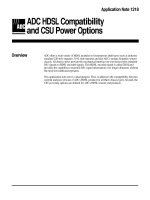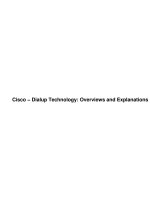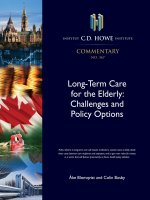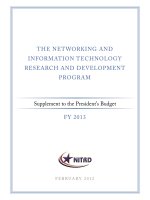WIRELESS TECHNOLOGY PROSPECTS AND POLICY OPTIONS doc
Bạn đang xem bản rút gọn của tài liệu. Xem và tải ngay bản đầy đủ của tài liệu tại đây (922.42 KB, 113 trang )
Copyright © National Academy of Sciences. All rights reserved.
Wireless Technology Prospects and Policy Options
Committee on Wireless Technology Prospects and Policy Options
Computer Science and Telecommunications Board
Division on Engineering and Physical Sciences
WIRELESS TECHNOLOGY
PROSPECTS AND POLICY OPTIONS
Copyright © National Academy of Sciences. All rights reserved.
Wireless Technology Prospects and Policy Options
THE NATIONAL ACADEMIES PRESS 500 Fifth Street, N.W. Washington, DC 20001
NOTICE: The project that is the subject of this report was approved by the Govern-
ing Board of the National Research Council, whose members are drawn from the
councils of the National Academy of Sciences, the National Academy of Engineer-
ing, and the Institute of Medicine. The members of the committee responsible
for the report were chosen for their special competences and with regard for
appropriate balance.
Support for this project was provided by the National Science Foundation under
award number CNS-0238131. Any opinions, findings, conclusions, or recom-
mendations expressed in this publication are those of the authors and do not
necessarily reflect the views of the organization that provided support for the
project.
International Standard Book Number-13: 978-0-309-16398-9
International Standard Book Number-10: 0-309-16398-6
Copies of this report are available from:
The National Academies Press
500 Fifth Street, N.W., Lockbox 285
Washington, DC 20055
(800) 624-6242
(202) 334-3313 (in the Washington metropolitan area)
Internet:
Copyright 2011 by the National Academy of Sciences. All rights reserved.
Printed in the United States of America
Copyright © National Academy of Sciences. All rights reserved.
Wireless Technology Prospects and Policy Options
The National Academy of Sciences is a private, nonprofit, self-perpetuating
society of distinguished scholars engaged in scientific and engineering research,
dedicated to the furtherance of science and technology and to their use for the
general welfare. Upon the authority of the charter granted to it by the Congress
in 1863, the Academy has a mandate that requires it to advise the federal govern-
ment on scientific and technical matters. Dr. Ralph J. Cicerone is president of the
National Academy of Sciences.
The National Academy of Engineering was established in 1964, under the charter
of the National Academy of Sciences, as a parallel organization of outstanding
engineers. It is autonomous in its administration and in the selection of its mem-
bers, sharing with the National Academy of Sciences the responsibility for advis-
ing the federal government. The National Academy of Engineering also sponsors
engineering programs aimed at meeting national needs, encourages education
and research, and recognizes the superior achievements of engineers. Dr. Charles
M. Vest is president of the National Academy of Engineering.
The Institute of Medicine was established in 1970 by the National Academy of
Sciences to secure the services of eminent members of appropriate professions
in the examination of policy matters pertaining to the health of the public. The
Institute acts under the responsibility given to the National Academy of Sciences
by its congressional charter to be an adviser to the federal government and, upon
its own initiative, to identify issues of medical care, research, and education.
Dr. Harvey V. Fineberg is president of the Institute of Medicine.
The National Research Council was organized by the National Academy of
Sciences in 1916 to associate the broad community of science and technology
with the Academy’s purposes of furthering knowledge and advising the federal
government. Functioning in accordance with general policies determined by the
Academy, the Council has become the principal operating agency of both the
National Academy of Sciences and the National Academy of Engineering in pro-
viding services to the government, the public, and the scientific and engineering
communities. The Council is administered jointly by both Academies and the
Institute of Medicine. Dr. Ralph J. Cicerone and Dr. Charles M. Vest are chair and
vice chair, respectively, of the National Research Council.
www.nati onal-academies.org
Copyright © National Academy of Sciences. All rights reserved.
Wireless Technology Prospects and Policy Options
Copyright © National Academy of Sciences. All rights reserved.
Wireless Technology Prospects and Policy Options
v
COMMITTEE ON WIRELESS TECHNOLOGY
PROSPECTS AND POLICY OPTIONS
DAVID E. LIDDLE, U.S. Venture Partners, Chair
YOCHAI BENKLER, Harvard University
DAVID BORTH, Motorola Labs
ROBERT W. BRODERSEN, University of California, Berkeley
DAVID D. CLARK, Massachusetts Institute of Technology
THOMAS (TED) DARCIE, University of Victoria
DALE N. HATFIELD, University of Colorado, Boulder
MICHAEL L. KATZ, New York University
PAUL J. KOLODZY, Kolodzy Consulting
LARRY LARSON, University of California, San Diego
DAVID P. REED, Massachusetts Institute of Technology
GREGORY ROSSTON, Stanford University
DAVID SKELLERN, National ICT Australia
Staff
JON EISENBERG, Director, Computer Science and
Telecommunications Board
Copyright © National Academy of Sciences. All rights reserved.
Wireless Technology Prospects and Policy Options
vi
COMPUTER SCIENCE AND TELECOMMUNICATIONS BOARD
ROBERT F. SPROULL, Oracle Corporation, Chair
PRITHVIRAJ BANERJEE, Hewlett-Packard Company
STEVEN M. BELLOVIN, Columbia University
SEYMOUR E. GOODMAN, Georgia Institute of Technology
JOHN E. KELLY III, IBM
JON M. KLEINBERG, Cornell University
ROBERT KRAUT, Carnegie Mellon University
SUSAN LANDAU, Radcliffe Institute for Advanced Study
DAVID E. LIDDLE, U.S. Venture Partners
WILLIAM H. PRESS, University of Texas, Austin
PRABHAKAR RAGHAVAN, Yahoo! Labs
DAVID E. SHAW, D.E. Shaw Research
ALFRED Z. SPECTOR, Google, Inc.
JOHN A. SWAINSON, Silver Lake
PETER SZOLOVITS, Massachusetts Institute of Technology
PETER J. WEINBERGER, Google, Inc.
ERNEST J. WILSON, University of Southern California
Staff
JON EISENBERG, Director
VIRGINIA BACON TALATI, Associate Program Officer
SHENAE BRADLEY, Senior Program Assistant
RENEE HAWKINS, Financial and Administrative Manager
HERBERT S. LIN, Chief Scientist
EMILY ANN MEYER, Program Officer
LYNETTE I. MILLETT, Senior Program Officer
ERIC WHITAKER, Senior Program Assistant
ENITA A. WILLIAMS, Associate Program Officer
For more information on CSTB, see its website at
, write to CSTB, National Research Council,
500 Fifth Street, N.W., Washington, DC 20001, call (202) 334-2605,
or e-mail the CSTB at
Copyright © National Academy of Sciences. All rights reserved.
Wireless Technology Prospects and Policy Options
vii
The use of radio-frequency communication—commonly referred to
as wireless communication—is becoming more pervasive as well as more
economically and socially important. Technological progress over many
decades has enabled the deployment of several successive generations
of cellular telephone technology, which is now used by many billions
of people worldwide; the near-universal addition of wireless local area
networking to personal computers; and a proliferation of actual and pro-
posed uses of wireless communications. The flood of new technologies,
applications, and markets has also opened up opportunities for exam-
ining and adjusting the policy framework that currently governs the
management and use of the spectrum and the institutions involved in it,
and models for allocating spectrum and charging for it have come under
increasing scrutiny.
Yet even as many agree that further change to the policy framework is
needed, there is debate about precisely how the overall framework should
be changed, what trajectory its evolution should follow, and how dramatic
or rapid the change should be. Many groups have opinions, positions,
demands, and desires related to these questions—reflecting multiple com-
mercial, social, and political agendas and a mix of technical, economic, and
social perspectives.
The development of technologies and associated policy and regula-
tory regimes are often closely coupled, an interplay apparent as early as
the 1910s, when spectrum policy emerged in response to the growth of
radio communications. As outlined in this report, current and ongoing
Preface
Copyright © National Academy of Sciences. All rights reserved.
Wireless Technology Prospects and Policy Options
viii PREFACE
technological advances suggest the need for a careful reassessment of the
assumptions that inform spectrum policy in the United States today.
This report of the Committee on Wireless Technology Trends and
Policy Options (Appendix A) thus seeks to shine a spotlight on 21st-
century technology trends and to outline the implications of emerging
technologies for spectrum management in ways that the committee hopes
will be useful to those setting future spectrum policy. Speakers at the
meetings held by the committee are listed in Appendix B. The detailed
statement of task for the study is given in Appendix C.
The committee was not in a position to examine details of the numer-
ous specific areas of contention that are the subject of frequent debate
today or to evaluate the merits of opposing claims. This report thus
does not offer specific prescriptions for how particular frequency bands
should be used or seek to resolve conflicting demands for spectrum use
for particular services. Instead, the committee offers a discussion of the
technology trends and related policy options relevant to addressing these
conflicts, both today and in the future.
The development of this report was not without its own challenges,
and the report was a long time in the making. Early on, the committee’s
work expanded in scope following a request from the National Tele-
communications and Information Administration to convene a forum
on spectrum policy reform options.
1
Later, a variety of circumstances
unrelated to the substance or the work of the committee led to unexpected
delays. Throughout the project, there were also reminders that its subject
is inherently complex and challenging. The technology and policy issues
are tightly intertwined, and the study involved experts from multiple
disciplines, including economics, law, public policy, electrical engineer-
ing, and computer science. The multidisciplinary approach sought yields
a more comprehensive view of a problem, but more time and effort are
needed to establish a common view of the issues, a common vocabulary,
and so forth. Finally, the technical and policy perspectives of the mem-
bers of the committee were, by design, diverse. As a result, the technol-
ogy considerations, enablers of a more nimble policy framework, and
policy options developed by the committee are the products of a multi-
dimensional examination of the issues and negotiation of agreements
among members holding often-contrasting opinions.
1
National Research Council, Summary of a Forum on Spectrum Management Policy Reform,
The National Academies Press, Washington, D.C., 2004.
Copyright © National Academy of Sciences. All rights reserved.
Wireless Technology Prospects and Policy Options
ix
This report has been reviewed in draft form by individuals chosen
for their diverse perspectives and technical expertise, in accordance with
procedures approved by the National Research Council’s Report Review
Committee. The purpose of this independent review is to provide candid
and critical comments that will assist the institution in making its pub-
lished report as sound as possible and to ensure that the report meets
institutional standards for objectivity, evidence, and responsiveness to
the study charge. The review comments and draft manuscript remain
confidential to protect the integrity of the deliberative process. We wish
to thank the following individuals for their review of this report:
Vinton G. Cerf, Google, Inc.,
John M. Cioffi, Stanford University,
Gerald R. Faulhaber, University of Pennsylvania,
Kevin C. Kahn, Intel Corporation,
Teresa H. Meng, Stanford University,
Dipankar Raychaudhuri, Rutgers University,
David H. Staelin, Massachusetts Institute of Technology,
Andrew J. Viterbi, The Viterbi Group, and
Steven S. Wildman, Michigan State University.
Although the reviewers listed above have provided many construc-
tive comments and suggestions, they were not asked to endorse the con-
clusions or recommendations, nor did they see the final draft of the report
Acknowledgment of Reviewers
Copyright © National Academy of Sciences. All rights reserved.
Wireless Technology Prospects and Policy Options
x ACKNOWLEDGMENT OF REVIEWERS
before its release. The review of this report was overseen by R. Stephen
Berry, University of Chicago. Appointed by the National Research Council,
he was responsible for making certain that an independent examination
of this report was carried out in accordance with institutional procedures
and that all review comments were carefully considered. Responsibility
for the final content of this report rests entirely with the authoring com-
mittee and the institution.
Copyright © National Academy of Sciences. All rights reserved.
Wireless Technology Prospects and Policy Options
xi
SUMMARY 1
1 INTRODUCTION: TRENDS AND FORCES RESHAPING 14
THE WIRELESS WORLD
Advances in Radio Technology, 15
Expansion in Applications and Users, 17
Changing Market Dynamics, 20
The Evolving Policy and Regulatory Framework, 21
2 KEY TECHNOLOGY CONSIDERATIONS 33
Technological Advances in Radios and Systems of Radios, 34
Low-Cost, Portable Radios at Frequencies of 60 GHz and
Above, 52
Interference as a Property of Radios and Radio Systems,
Not Radio Signals, 53
Enduring Technical Challenges, 55
Timescales for Technology Deployment, 57
Talent and Technology Base for Developing Future Radio
Technology, 58
Measurements of Spectrum Use, 59
Challenges Facing Regulators, 63
Engineering Alone Is Often No Solution, 66
Contents
Copyright © National Academy of Sciences. All rights reserved.
Wireless Technology Prospects and Policy Options
xii CONTENTS
3 POLICY OPTIONS 67
Pressures on Today’s Wireless Policy Framework, 67
Key Considerations for a Future Policy Framework, 68
Technology-Enabled Policy Options, 76
APPENDIXES
A Biographies of Committee Members and Staff 87
B Speakers at Meetings 96
C Statement of Task 99
Copyright © National Academy of Sciences. All rights reserved.
Wireless Technology Prospects and Policy Options
1
Today’s framework for wireless policy—which governs the opera-
tion of devices that make use of radio-frequency (RF) transmissions—has
its roots in the technology of 80 years ago and the desire at that time for
governmental control over communications. It has evolved to encompass
a patchwork of legacy rules and more modern approaches that have been
added over time. Although views vary considerably on whether the pace
of reform has been commensurate with the need or opportunity, there
have been a number of significant policy changes in recent decades to
adjust to new technologies and to decrease reliance on centralized man-
agement. These developments have included the use of auctions to make
initial assignments (along with the creation of secondary markets to trade
assignment rights) and the designation of open bands
1
in which all users
are free to operate subject only to a set of “rules of the road.”
There remains, nonetheless, much debate about how the overall frame-
work should be changed, what trajectory its evolution should follow,
and how dramatic or rapid the change should be. Many groups have
opinions, positions, and demands related to these questions reflecting
multiple commercial, social, and political agendas and a mix of technical,
economic, and social perspectives.
1
A variety of terms are used to describe this approach, including “license-exempt” or
“license by rule.” The approach is probably most familiar as the basis for operation of wire-
less LANs, cordless telephones, and the like.
Summary
Copyright © National Academy of Sciences. All rights reserved.
Wireless Technology Prospects and Policy Options
2 WIRELESS TECHNOLOGY PROSPECTS AND POLICY OPTIONS
PRESSURES ON TODAY’S WIRELESS POLICY FRAMEWORK
The current framework for wireless policy in the United States is
under pressure on several fronts:
• It continues to rely heavily on service-specific allocations and
assignments that are made primarily by frequency band and geographic
location and does not embrace all of the spectrum management approaches
possible with today’s technologies and expected to be available with
tomorrow’s technologies.
• Despite revisions aimed at creating greater flexibility, it continues
to rely significantly on centrally managed allocation and assignment, with
government regulators deciding how and by whom wireless communica-
tions are to be used despite growing agreement that central management
by regulators is inefficient and insufficiently flexible.
• It will not be able to satisfy the increasing and broadening demand
for wireless communications that is spurred by interest in richer media,
seemingly insatiable demand for mobile and untethered access to the
Internet and the public telephone network, and growing communication
among devices as well as people.
• It does not fully reflect changes in how radios are being built and
deployed now or in how they could be built and deployed in the future
in response to different regulations, given that technological innova-
tion has expanded the range of potential wireless services and the range
of technical means for providing those services and at the same time
has dramatically lowered the cost of including wireless functionality in
devices.
Today, the complexity and density of existing allocations, assign-
ments, and uses, and the competing demands for new uses, all make
policy change difficult. Decisions will necessarily involve (1) addressing
the costs and benefits of proposed changes that are (often unevenly) dis-
tributed over multiple parties, (2) resolving conflicting claims about costs
and benefits, and (3) addressing coordination issues, which are especially
challenging if achieving a particular change requires actions by a large
number of parties. Moreover, some parties stand to gain by changing—or
advocating for change—while others stand to gain by delay or retaining
the status quo.
FORWARD-LOOKING POLICY DIRECTIONS
The Committee on Wireless Technology Prospects and Policy Options
believes that, moving forward, the unambiguous goal for spectrum policy
Copyright © National Academy of Sciences. All rights reserved.
Wireless Technology Prospects and Policy Options
SUMMARY 3
should be to make the effective supply of spectrum plentiful so as to
make it cheaper and easier to innovate and introduce new or enhanced
services. Put another way, the goal should be to reduce the total cost—
which includes the cost, if any, of licenses, and the cost of equipment,
both for the end user and the network—of introducing or enhancing
services. The financial cost of adverse impacts to existing users and ser-
vices should also be fairly evaluated and debated in advance of regula-
tory changes.
Given the plethora of existing allocations and assignments, and the
multitude of existing services and users associated with them, it is not
possible to take a clean-slate approach. Achieving the goal stated above
will thus involve several parallel efforts:
• Leveraging advanced technologies, regulation, and market-based incen-
tives to support sharing, including overlay and underlay approaches, so
that new services can share spectrum with legacy services.
• Streamlining and modernizing the use of bands allocated or assigned to
old services to free up new areas of “white space” that can be used for new ser-
vices, by using market mechanisms, relinquishing government-controlled
bands used for obsolete services, and shutting down obsolete services (as
has happened with analog television).
• Establishing “open” as the default policy regime used at 20 to 100 giga-
hertz (GHz). At these higher frequencies, sparser use and technical charac-
teristics that significantly reduce the chance for interference suggest that
nontraditional management approaches can predominate.
The likelihood of ongoing technological change also points to the value of
establishing a more adaptive learning system for setting policy that would
be better able to track and even anticipate advances in wireless technology
and emerging ways of implementing and using wireless services.
The sections that follow provide a brief description of key technology
considerations and outline policy options, many enabled by new technol-
ogy, that will be useful in achieving the goal of increasing the supply of
spectrum for enhanced or new services.
KEY TECHNOLOGY CONSIDERATIONS
Radio-frequency communication has been transformed profoundly
in recent years by a number of technological advances. This section
outlines key recent advances and associated trends and their implica-
tions for the design of radios and radio systems and for regulation and
policy.
Copyright © National Academy of Sciences. All rights reserved.
Wireless Technology Prospects and Policy Options
4 WIRELESS TECHNOLOGY PROSPECTS AND POLICY OPTIONS
Profound Changes in Radio-Frequency Communication as a
Result of Technological Advances in Radios and Radio Systems
Digital processing is used increasingly to detect the desired signal and
to reject interfering signals. The shift to largely digital radios built using
complementary metal oxide semiconductor (CMOS) technology; (a high-
density, low-power-consumption technology for constructing integrated
circuits) has made it much cheaper and easier to include wireless capabili-
ties in consumer electronic devices. As a result of the reduction in costs
for radio technology, the barriers to developing and deploying novel, low-cost,
specialized radios have become much lower, and more firms and other organiza-
tions have become capable of and potentially motivated to participate. Growth
in the number of wireless devices of various types and in the demand for
wireless communications is likely to continue.
Technological capabilities are also driving the introduction of new
radio system architectures, including a shift away from centralized systems
to more localized transmissions in distributed systems that use very small cells
(the smallest of those being deployed today are called femtocells) or mesh
networks, and a shift from centralized switching to more distributed,
often Internet-Protocol-based, networks.
Another important shift in radios has been the ability to use new
techniques to permit greater dynamic exploitation of all available degrees of
freedom—frequency, space, time, and polarization—which makes it possible to
take greater advantage in a dynamic, fine-grained, and automated fashion
of all the degrees of freedom to distinguish signals. This capability offers
the opportunity to introduce new options for assigning usage rights.
The ability to leverage sustained improvements in the performance of
digital logic also opens up opportunities to build radios that are much more
flexible and adaptable. Such radios can change their operating frequency
and modulation scheme, can sense and respond to their environment,
and can operate cooperatively to create new opportunities to make more
dynamic, shared, and independently coordinated use of spectrum. (They
cannot, however, directly sense passive users, which means that special
measures such as registries or beacons are needed for detection of passive
users.) The result is that radios and systems of radios can operate and
cooperate in an increasingly dynamic and autonomous manner.
Although increased flexibility involves greater complexity, cost, and
power consumption, it enables building radios that can better coexist with
existing radio systems, through both underlay (low-power use intended
to have a minimal impact on the primary user) and overlay (agile use by
a secondary user of “holes” in the time and space of use by the primary
user). Moreover, flexibility makes it possible to build radios with operating
parameters that can be modified to comply with future policy or rule changes or
future service requirements.
Copyright © National Academy of Sciences. All rights reserved.
Wireless Technology Prospects and Policy Options
SUMMARY 5
The use of CMOS to build radios and digital processing together with
other advances in RF technology opens up a new set of opportunities in
the form of low-cost, portable radios that are becoming increasingly practical at
frequencies of 60 GHz and above. Radios operating in this domain must con-
front a number of challenges, including limited free-space propagation
distances (especially in the oxygen absorption bands around 60 GHz)
and very limited penetration through and diffraction around walls of
buildings or other obstacles. On the other hand, these characteristics
make such radios very useful in providing very large bandwidths over
short range.
Interference as a Property of Radio Receivers and Radio Systems,
Not Radio Signals
It is commonplace to talk about radio signals interfering with each
other, a usage that mirrors the common experience of hearing broad-
cast radio signals that are transmitted on the same channel overlay each
another. However, radio signals themselves do not, generally speaking,
interfere with each other in the sense that information is destroyed. Inter-
ference reflects a receiver’s inability to distinguish between the desired
and undesired signals. The cost of separating these signals is ultimately reflected
in design complexity, hardware cost, and power consumption. As a result, any
practical radio (i.e., one of practical size, cost, and power consumption)
will necessarily throw away some of the information needed to resolve
signal ambiguity. As the performance and capabilities of radios continue
to improve over time, their ability to distinguish between signals can be
expected to improve. However, power consumption will remain an espe-
cially challenging constraint, especially for portable devices, and even a
modest additional device cost can jeopardize the commercial viability of
a product or service.
Persisting Technical Challenges
Even as the capabilities and the performance of radios continue to
improve, several hard technical problems can be expected to persist. These
technical challenges—discussed in more detail below in this report—
include power consumption, nonlinearity of radio components, support
for nomadic operation and mobility, and coping with the heterogeneity
of capabilities, including both legacy equipment and systems that are
inherently constrained, such as embedded network sensors and scientific
instruments that passively use spectrum (e.g., for remote Earth sensing
and radio astronomy).
Copyright © National Academy of Sciences. All rights reserved.
Wireless Technology Prospects and Policy Options
6 WIRELESS TECHNOLOGY PROSPECTS AND POLICY OPTIONS
Nonuniform Timescales for Technology Replacement
Different wireless services are characterized by the different time-
scales for removal of old technology from service and deployment of new
technology. The factors influencing the turnover time include the time to
build out the infrastructure, the time to turn over the base of end-user
devices, and the time to convince existing users (who may be entrenched
and politically powerful) to make—and pay for—a shift, as well as the
incentives for upgrading and the size of the installed base.
Considerable Uncertainty About the Rate at Which
New Technologies Can Be Deployed Practically
A particular challenge in contemplating changes to policy or regula-
tory practice is determining just how quickly promising new technologies
will be deployable as practical devices and systems and thus how quickly,
and in what directions, policy should be adjusted. As is natural with all
rapidly advancing technologies, the concepts and prototypes are often well
ahead of what has been proved to be technically feasible or commercially viable.
At the same time, technical advances sometimes can be commercialized
quickly, although deployment and use might also require adjustments to
regulations, a process that historically has taken longer.
Spectrum Use Lower Than Allocations and Assignments Suggest,
Especially at Higher Frequencies
Quantifying how well and how efficiently spectrum is used is quite
challenging. Measurements may miss highly directional or periodic use
and cannot detect passive uses such as radio astronomy. These caveats
notwithstanding, measurements suggest that some allocated and assigned
frequency bands are very heavily used whereas others are only lightly
used, at least in certain places and at certain times. The published fre-
quency allocation and assignment charts are thus potentially misleading
in their suggestion that little spectrum is available for new applications
and services. A good deal of empty space exists in the spectrum; the chal-
lenge is to find ways of safely detecting and using it.
ENABLERS OF A MORE NIMBLE, FORWARD-LOOKING
SPECTRUM POLICY FRAMEWORK
The committee identified the following approaches as enablers of a
more nimble approach to spectrum policy.
Copyright © National Academy of Sciences. All rights reserved.
Wireless Technology Prospects and Policy Options
SUMMARY 7
Abandon the Extremes in the
“Property Rights” Versus “Commons” Debate
The terms “property rights” and “commons” are shorthand for par-
ticular approaches to spectrum management—approaches that reflect
philosophical and ideological perspectives as well as technical and policy
alternatives. The property rights approach relies on a well-specified and
possibly exclusive license to operate and on rights that can be established
or transferred through an administrative proceeding, auction, or market
transaction. It is intended to facilitate the creation of a market in infra-
structure access and use rights. The commons or open-access approach
relies on establishing license-free bands in which users must comply with
specified rules, such as limits on transmitted power. It is intended to
facilitate a market in devices and services based on symmetrically applied
infrastructure use and access rights.
Each has advantages and disadvantages and associated transaction
costs. Each involves different incentives, and different and complemen-
tary loci, for innovation. When carefully specified, neither pure version
can at present be determined to be uniquely “better” than the other. More-
over, there is a much larger space of alternatives, and commercial forces
can help drive their evolution and selection provided that the regulatory
structure is not overly rigid. This suggests adopting a policy framework
that avoids detailed allocation of spectrum in favor of one that uses
market mechanisms for spectrum allocation where they make sense and
uses an open-access mechanism in other instances. Where to draw the line
between the two general approaches (licensed or exclusive-use allocations
versus open access)—and which hybrids of the two approaches might be
useful—will shift as technological capabilities, deployed services, and
business models continue to evolve.
Leverage Standards Processes but Understand Their Limitations
Regulators often rely, either explicitly or implicitly, on standards
bodies to define the technical standards that are ultimately needed to
implement rulings for proposed new allocations and services. On the one
hand, standards-setting organizations are viewed as being more nimble
and better able than regulatory bodies to focus on technical issues. On
the other hand, as standards take on greater importance, the number of
competing players and conflicting interests grows, raising the risks that a
large player may try to dominate the process, that standards setting may
deadlock, or that only certain societal interests are reflected. Some ways to
address these risks have been identified, such as the use of one company,
one vote to deal with attempts to dominate by sending multiple delegates,
but such an approach has tradeoffs as well.
Copyright © National Academy of Sciences. All rights reserved.
Wireless Technology Prospects and Policy Options
8 WIRELESS TECHNOLOGY PROSPECTS AND POLICY OPTIONS
Collect More Data on Spectrum Use
There are many gaps today in knowledge about the use of spectrum.
Measuring use is difficult and has not been done systematically, leading
to uncertainty for policy makers, who are not able to readily assess claims
and counterclaims about the use or nonuse of spectrum. Advances in
radio technology, however, make it possible to contemplate new ways
of collecting data on spectrum use, such as by the deployment of net-
works of sensors and the incorporation of sensing capabilities in equip-
ment deployed for other purposes. Such capabilities would enhance the
ability of regulators to enforce compliance with operating rules, and to
more quickly assess conflicting claims about harmful interference and
provide the data required to implement spectrum management schemes
that depend on identifying unused spectrum.
Ensure That Regulators Have Access to Technology Expertise
Needed to Address Highly Technical Issues
As this report argues, spectrum policy is entering an era in which
technical issues are likely to arise on a sustained basis as technologies,
applications, and services continue to evolve. The committee believes that
the Federal Communications Commission (FCC) would therefore benefit
from enhancing its technology assessment and engineering capabilities
and suggests several ways to gain such expertise:
• Make it a priority to recruit top-caliber engineers/scientists to
work at the FCC, perhaps for limited terms.
• Use an external advisory committee to provide the FCC with out-
side, high-level views of key technical issues. (Indeed, in the past, the FCC
convened the Technology Advisory Council to play just such a role.
2
)
• Add technical experts to the staff of each commissioner.
• Tap outside technical expertise, including expertise elsewhere in
the federal government such as at the Department of Commerce’s Insti-
tute for Telecommunication Sciences and the National Institute of Stan-
dards and Technology (NIST), or through a federally funded research and
development center.
2
The FCC announced the appointment of a new Technology Advisory Council in October
2010, as this report was being prepared for publication.
Copyright © National Academy of Sciences. All rights reserved.
Wireless Technology Prospects and Policy Options
SUMMARY 9
Sustain Talent and Technology Base for Future Radio Technology
The opportunities described in this report rely on innovation in both
technology and policy. Innovation in wireless technology involves many
areas of science and engineering—including RF engineering, digital logic,
CMOS, networking, computer architecture, applications, policy, and
economics—and often expertise in combinations of these areas that is dif-
ficult to obtain in a conventional degree program. Research investments
in wireless technologies by federal agencies such as the National Sci-
ence Foundation, Defense Advanced Research Projects Agency, National
Telecommunications and Information Administration, and NIST help to
build the knowledge base for future innovation and to educate and train
tomorrow’s wireless engineering talent. Research efforts can be buttressed
by an infrastructure for implementing and testing new ideas in radios and
systems of radios. Test beds allow radio system architectures to be tested
at scale, and access to facilities for integrated circuit design and fabrica-
tion makes it possible to build prototypes.
FORWARD-LOOKING POLICY OPTIONS
Consider “Open” as the Default Policy Regime at a
Frequency Range of Approximately 20 to 100 GHz
At frequencies of 20 to 100 GHz, the potential for legacy problems
and for interference (in the classical sense) is lower, suggesting that non-
traditional (open) approaches could predominate for use of spectrum at
20 to 100 GHz.
3
Adopting an open approach for a frequency domain that
will become increasingly more technologically accessible and commer-
cially attractive several years from now would set the stage for more flex-
ible and adaptive future spectrum management. FCC policy has already
moved in this general direction, with an unlicensed regime established
in a band at 57 to 64 GHz and licensed access to bands at 80 and 95 GHz
made available on a first-come, first-protected basis.
Spectrum use is relatively low at 20 to 100 GHz compared to use at
frequencies below 20 GHz, but existing users are likely to argue vocifer-
ously for ongoing protection, and some exceptions to the open rule will
probably be needed to protect certain established services and passive
scientific uses.
3
It would be imprudent to recommend a particular regime for frequencies above 100 GHz
given today’s limited understanding of how radios might be constructed or operated in that
domain, and it would be prudent to review policy in this area every several years and make
adjustments as appropriate.
Copyright © National Academy of Sciences. All rights reserved.
Wireless Technology Prospects and Policy Options
10 WIRELESS TECHNOLOGY PROSPECTS AND POLICY OPTIONS
Use New Approaches to Mitigate Interference and a
Wider Set of Parameters in Making Assignments
Protecting against harm from interference has both technical aspects
(how well a radio or radio system can separate the desired from undesired
signals) and economic dimensions (the costs of building, deploying, and
operating a radio or radio system with particular technical characteristics
that make it easier to separate the signals).
Provided that the transaction costs are low enough and that agreed-
upon protocols for coordination exist, usage “neighbors” can negotiate
mutually satisfactory solutions to interference problems that take into
account the financial benefits, costs, and technology opportunities.
4
Given
the complexity of defining the technological options for any given com-
munication in the context of other local attempts to communicate, as well
the difficulties of determining who is a “neighbor,” particularly for mobile
and nomadic systems, the transaction costs may be significant.
5
The size
of these costs and their implications for solutions that rely on negotiations
will depend on such factors as the number and diversity of systems and
users and is a subject of ongoing debate.
Receivers are increasingly able to discriminate a desired signal from
an undesired one, some technologies provide new tools for mitigating
interference, and other new technologies make it possible to exploit all
degrees of freedom in a dynamic fashion, opening new avenues for miti-
gating interference. Mitigation of interference can also be addressed in
terms of the behavior of systems of radios rather than of individual radios
and by coordinating the behavior of multiple systems. A key question is
how best to establish incentives for such cooperation.
Introduce Technological Capabilities That Enable
More Sophisticated Spectrum Management
The use of certain technologies, some of them emerging and some of
them available but not widely deployed, would make it easier to intro-
duce new services into crowded frequency bands. In particular it might
be possible to overlay unlicensed use onto licensed use if receivers were
suitably equipped. Another enabling technology is smart antennas that
could be used to focus transmitted power, scan the environment for other
transmissions, and spatially separate transmissions to help avoid inter-
ference. Migrating current nondigital services to more efficient digital
4
R.H. Coase, “The Federal Communications Commission,” Journal of Law and Economics
2(10):1-40, 1959.
5
Y. Benkler, “Some Economics of Wireless Communications,” Harvard Journal of Law and
Technology 16(1):25-83, 2002.
Copyright © National Academy of Sciences. All rights reserved.
Wireless Technology Prospects and Policy Options
SUMMARY 11
transmission will be a major challenge, especially for services that have
large and/or politically powerful legacy bases.
Migrating to higher-quality receivers has a cost in dollars, design
complexity, and power consumption. Even small additional costs matter
a great deal when service providers are fighting for pennies. But the addi-
tional investment could have a big payoff for those who seek to introduce
enhanced or new services.
Trade Near-Absolute Outcomes for Statistically Acceptable Outcomes
Although statistical models have long been used in spectrum analy-
sis, the underlying conservative assumptions have emphasized avoidance
of interference to an extent that has significantly affected efficient use of
spectrum. An alternative is to relax constraints so as to normally (but not
always) provide good outcomes, as is done in both Internet communica-
tion (best-effort packet delivery) and cellular telephony (which provides
mobility in exchange for gaps in coverage and lower audio quality). With
this approach, adverse impacts on users would be rare even though tech-
nical performance might be measurably but tolerably worse for users. A
relaxation of requirements could significantly open up opportunities for
nonexclusive use of frequency bands through a rebalancing of the risk
of interference and the benefits of new services. This approach might
not be appropriate, however, for services that demand guarantees of
especially high-quality service (e.g., for certain safety-critical systems).
Although regulatory proceedings could be used to implement such a
shift, it might be preferable for licensees to negotiate mutually beneficial
arrangements.
Design for Light as Well as Design for Darkness
Many systems, notably cellular phones, have been “designed for
darkness”—that is, with the assumption that a particular band has been
set aside for a particular service or operator and that there are no other
emissions in that band. An alternative is to “design for light,” with the
assumption that the operating environment will be noisy and cluttered.
Both approaches are reasonable for certain applications and services, but
there are tradeoffs between (1) the ease with which higher spectral effi-
ciency can be achieved under design for darkness, thus allowing for lower
cost and reduced power consumption and (2) the greater flexibility to sup-
port multiple and diverse uses under design for light. The historical pref-
erence has been to design for darkness, but today technological advances
suggest opening up more bands in the design-for-light modality.
Copyright © National Academy of Sciences. All rights reserved.
Wireless Technology Prospects and Policy Options
12 WIRELESS TECHNOLOGY PROSPECTS AND POLICY OPTIONS
Consider Regulation of Receivers and Networks of Transceivers
Much regulation has focused on transmitters, and rules have speci-
fied transmission frequency and bandwidth, geographical location, and
transmission power. Increasing use of new radio architectures (discussed
above) suggests that the scope of inquiry can be broadened to look at the
properties and behaviors of receivers and networks of transceivers. Better
receiver standards would create an environment in which receiver capa-
bilities present a lower barrier than they do today for implementing new
spectrum-sharing schemes. Expanding the scope of policy or regulation
to include a system of radios rather than an individual radio would open
up new opportunities, such as the possibility of exploiting a network of
radios to reliably use a listen-before-send protocol to avoid interference
and thereby avoid the hidden node problem, in which one radio cannot
detect transmissions from another radio.
Exploit Programmability So That Radio Behavior
Can Be Modified to Comply with Operating Rule Changes
Because radios can be made highly programmable, albeit with
tradeoffs in complexity, cost, and power consumption, their operat-
ing parameters can be made modifiable to comply with policy or rule
changes. Deployment of devices with such capabilities opens up new
opportunities for more flexible regulation and more incremental policy
making: (1) policies could be written less precisely up front, (2) policies
would not have to be homogeneous and could be adapted to local envi-
ronmental conditions such as signal density, (3) the operating rules of
existing devices could be revised to accommodate new technology, and
(4) devices could more easily be certified for international use because
they can readily be switched to comply with local policy. One result could
be greater speed of deployment for new technologies and services.
6
Over
time, the introduction of such capabilities could be expected to impose a
less onerous performance and cost penalty. Future regulations could take
advantage of this opportunity by specifying, for example, that licenses
granted after a certain date would require use of devices with a certain
degree of reprogrammability.
6
Caveat: this flexibility could also paradoxically represent a disincentive to deployment
because it opens up the possibility of future forced sharing, potentially reducing the value
of a particular license.









